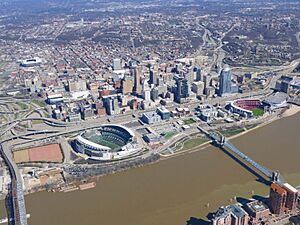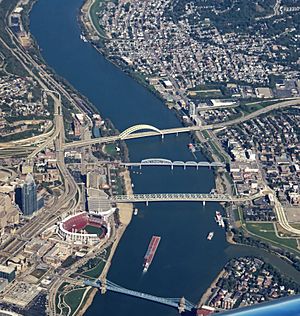Downtown Cincinnati facts for kids
Quick facts for kids
Downtown
|
|
|---|---|
|
Neighborhood
|
|
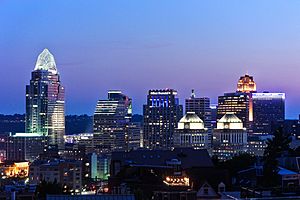
Downtown Cincinnati viewed from Mt. Adams
|
|
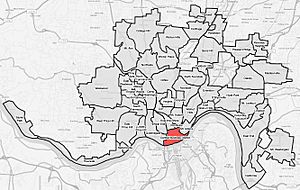
Location within Cincinnati
|
|
| Country | United States |
| State | Ohio |
| City | Cincinnati |
| Elevation | 660 ft (201 m) |
| Population
(2020)
|
|
| • Total | 5,835 |
| Time zone | UTC-5 (EST) |
| • Summer (DST) | UTC-4 (EDT) |
| ZIP code |
45202
|
| Website | Downtown Cincinnati |
Downtown Cincinnati is a busy and important part of Cincinnati, Ohio. It's one of the city's 52 neighborhoods. This area is like the city's main office, where many businesses are located. It's also a key center for the wider Cincinnati area. Long ago, many people lived here, but in the mid-1900s, it became more focused on businesses. In 2020, about 5,835 people lived in Downtown Cincinnati.
Contents
Exploring Downtown Cincinnati's Past
For a long time, Downtown Cincinnati was a very crowded place where many people lived. In the late 1800s, it was one of the most densely populated areas in any U.S. city. It held a large part of Cincinnati's total population. However, in the 1950s and 1960s, big city changes and new highways caused many older buildings to be removed. This changed Downtown into more of a business area.
Discovering Downtown Cincinnati's Location
Downtown Cincinnati is built in a natural bowl-shaped area next to the Ohio River. Steep hills surround this basin. The streets in Downtown Cincinnati are set up in a grid pattern, like a checkerboard. Vine Street divides the streets into east and west sections. Bridges from Downtown Cincinnati cross the Ohio River, connecting to Covington and Newport in Northern Kentucky.
The city government has clear boundaries for the neighborhood. To the north, it meets Over-the-Rhine and Pendleton at East Central Parkway. To the northwest, it borders West End at Plum Street. The western edge touches Queensgate along Interstate 75. To the east, it connects with Mount Adams at Eggleston Avenue.
Who Lives in Downtown Cincinnati?
| Downtown Cincinnati Population 1840-2020 | ||
|---|---|---|
| Year | Pop. | ±% |
| 1840 | 36,946 | — |
| 1850 | 38,970 | +5.5% |
| 1860 | 53,752 | +37.9% |
| 1870 | 51,393 | −4.4% |
| 1880 | 42,820 | −16.7% |
| 1890 | 36,076 | −15.7% |
| 1900 | 24,800 | −31.3% |
| 1910 | 20,050 | −19.2% |
| 1920 | 15,475 | −22.8% |
| 1930 | 12,443 | −19.6% |
| 1940 | 11,497 | −7.6% |
| 1950 | 12,126 | +5.5% |
| 1960 | 5,953 | −50.9% |
| 1970 | 3,472 | −41.7% |
| 1980 | 2,528 | −27.2% |
| 1990 | 3,846 | +52.1% |
| 2000 | 3,189 | −17.1% |
| 2010 | 4,850 | +52.1% |
| 2020 | 5,835 | +20.3% |
| Wards were utilized from 1840-1890 which have slightly different boundaries from census tracts utilized from 1900-40. | ||
In 2020, the census showed that 5,835 people lived in Downtown Cincinnati. There were 4,147 homes in the neighborhood. Most of the people living here were White (68.0%), followed by Black or African American (17.9%), and Asian (6.4%). A smaller number of people identified as Native American, Pacific Islander, or from two or more races.
About 17.2% of the households were families. Most households (64.4%) were made up of single individuals.
Only a small part of the population, 2.7%, was under 18 years old. The majority, 92.0%, were adults aged 18 to 64. About 5.3% were 65 years or older. More women (62.4%) lived in Downtown than men (37.6%).
From 2016 to 2020, the average yearly income for a household in Downtown was about $90,027. About 4.2% of families lived below the poverty line. A high number of adults, about 68.1%, had a bachelor's degree or higher.
Downtown Cincinnati's Economy
Downtown has always been the main business center of Cincinnati. In the mid-1800s, many of the city's banks were located on Third Street. This was close to the busy Public Landing river port. By the late 1800s, the center of business moved to Fourth Street, where it largely remains today.
Several big companies have their main offices in Downtown Cincinnati. These include Kroger, Fifth Third Bank, Procter & Gamble, Western & Southern Financial Group, American Financial Group, and Cincinnati Bell.
The Duke Energy Convention Center is Cincinnati's large meeting place. It opened in 1968 and has a huge space for events, about 750,000 square feet.
Exploring Downtown Cincinnati's Buildings

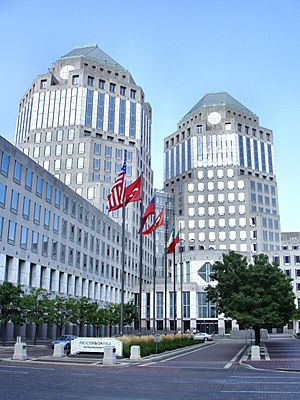
Downtown Cincinnati is famous for its many old and beautiful buildings. It has several historic areas and dozens of buildings listed on the National Register of Historic Places listings in downtown Cincinnati, Ohio.
Almost all of the tallest buildings in Cincinnati are found in Downtown. The Carew Tower even has a public observation deck on its 49th floor. From there, you can get amazing views of the city!
Since 1971, the Cincinnati Skywalk has connected buildings downtown. It's a series of elevated walkways, mostly indoors. The Skywalk was fully completed in 1997, stretching 1.3 miles. However, some parts have been removed over time.
Downtown Cincinnati's Culture and Fun
Downtown Cincinnati is becoming a popular place to live again. Old business spaces, like Park Place near Lytle, are being turned into fancy apartments.
You can find several museums downtown. These include the modern Contemporary Arts Center, the National Underground Railroad Freedom Center, and the Taft Museum of Art.
The Banks is a lively area along the waterfront. It has many bars and restaurants. This spot gets especially busy after games at the nearby Paycor Stadium and Great American Ball Park. These are the home stadiums for the Cincinnati Bengals (football) and Cincinnati Reds (baseball) teams.
The Backstage District, located around the Aronoff Center, offers many nightlife and dining choices.
Green Spaces: Downtown Cincinnati Parks
Fountain Square is often called the heart of Cincinnati. It's right in the middle of the main business district. The famous Tyler Davidson Fountain, dedicated in 1871, stands proudly in this busy city square. Other parks in Downtown include Lytle Park and Piatt Park.
Getting Around Downtown Cincinnati
Downtown is a major transportation hub for the entire region. Fort Washington Way helps connect interstates 71 and 75 with Route 50, making it easy to drive in and out.
The Southwest Ohio Regional Transit Authority (SORTA) runs public transportation. Their main hub is at Government Square. Downtown is also served by the Connector, a streetcar line. This streetcar connects Downtown with the Over-the-Rhine neighborhood.


